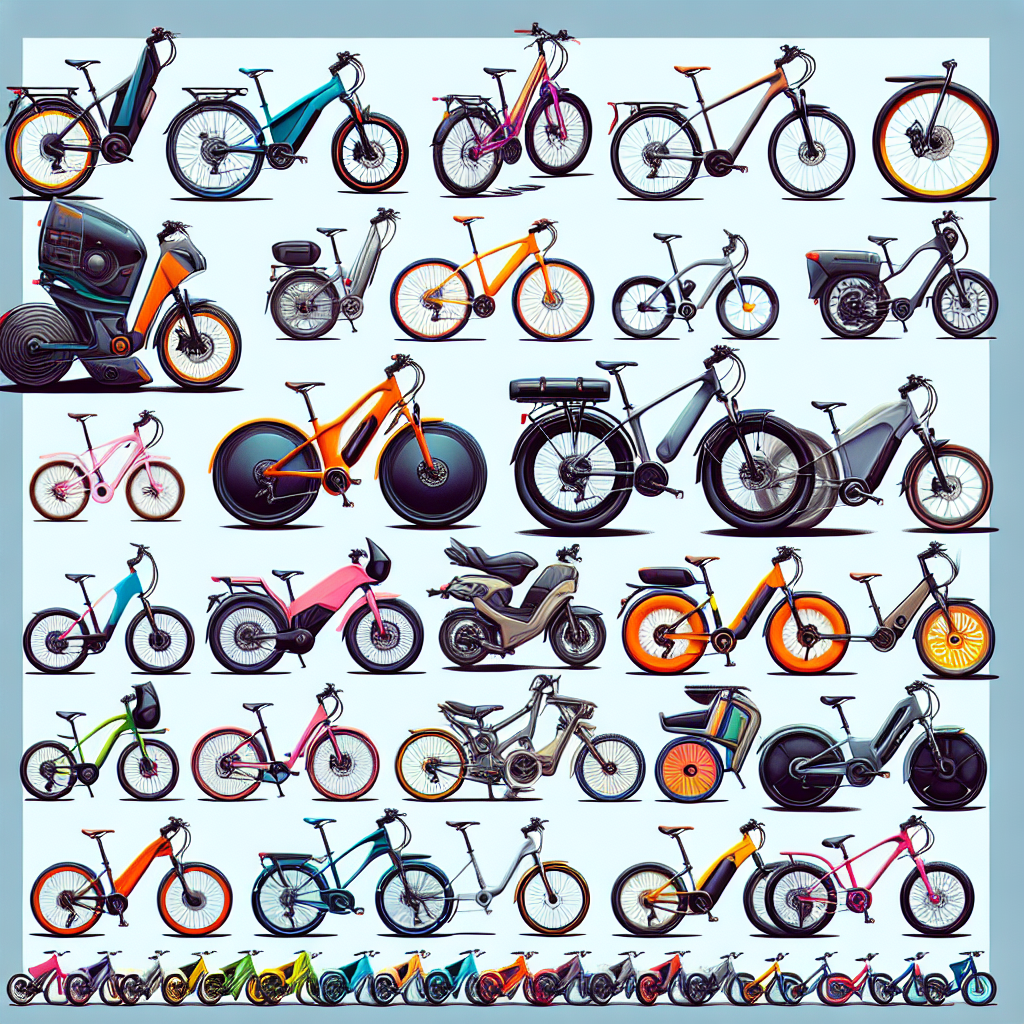If you’re curious about the price tag attached to e-bikes, you’re not alone! E-bikes have been gaining popularity as a convenient and eco-friendly mode of transportation, but many are unsure about the cost. Let’s uncover the mystery and explore how much e-bikes really cost. From budget-friendly options to high-end models, there’s an e-bike out there for every budget and lifestyle. Whether you’re a daily commuter or an adventure enthusiast, finding the perfect e-bike to suit your needs is easier than ever. So, let’s discover the world of e-bike pricing together!
Factors Influencing E-bike Prices
When it comes to purchasing an e-bike, there are a few factors that can significantly influence the price. Understanding these factors can help you make an informed decision and find the e-bike that fits your budget and needs. Here are the main factors that influence e-bike prices:
Type and Style of E-bike
The type and style of e-bike you choose can have a significant impact on its price. E-bikes come in various styles, including mountain bikes, city bikes, folding bikes, and cargo bikes, among others. Each style has its unique features and specifications, and the price will depend on the complexity and performance of the bike.
For example, mountain e-bikes designed for off-road adventures tend to be more expensive than city e-bikes designed for commuting. The components used, such as suspension systems and specialized gears, can increase the price of mountain e-bikes. On the other hand, city e-bikes may have a more straightforward design and lower specs, making them more affordable.
Motor and Battery
The motor and battery are crucial components of an e-bike, and their quality and power can greatly influence the price. E-bike motors come in various sizes and types, ranging from hub motors to mid-drive motors. Hub motors are typically less expensive, while mid-drive motors offer better performance and efficiency, but at a higher cost.
The battery is another essential factor that affects the price of an e-bike. Lithium-ion batteries are the standard choice for most e-bikes, but their capacity and quality can vary. Higher-capacity batteries that provide more range will generally add to the cost of the e-bike.
Frame Material
The frame material used in an e-bike can also impact its price. Common materials are aluminum, steel, carbon fiber, and titanium. Aluminum frames are the most common and tend to be more affordable, while carbon fiber and titanium frames are lightweight and high-performance but come at a premium price.
The choice of frame material depends on the intended use of the e-bike. If you’re looking for a lightweight and agile city bike, aluminum or carbon fiber frames are a great option. However, if you’re planning on taking your e-bike off-road and want extra durability, a steel frame might be a better choice.
Components and Accessories
The components and accessories included with an e-bike can vary greatly, and the quality and brand of these components can impact the price. Components such as brakes, gears, and suspension systems can greatly affect the performance and durability of an e-bike. Higher-end components from reputable brands will increase the price of the e-bike.
Additionally, accessories like lights, racks, fenders, and displays can enhance the functionality and aesthetics of an e-bike, but they can also add to the overall cost. When comparing e-bikes, consider the included components and accessories to determine if the price is justified based on your specific needs.
Entry-Level E-bikes
Entry-level e-bikes are often a popular choice for beginners or those on a tighter budget. These e-bikes provide an affordable entry point into the world of electric biking without compromising on essential features and specifications.
Price Range
Entry-level e-bikes usually fall in the range of $1,000 to $2,500. At this price point, you can expect a basic yet reliable e-bike with decent components and a standard battery and motor. While entry-level e-bikes may not offer the same power and advanced features as higher-end models, they are a great option for daily commuting and light recreational use.
Features and Specifications
Entry-level e-bikes typically come with a moderate motor power, usually ranging from 250 to 500 watts. The battery capacity is often sufficient for shorter rides or commutes, providing an average range of 30 to 50 miles on a single charge. The frame material is usually aluminum, ensuring a lightweight and durable build.
In terms of components, entry-level e-bikes may come with entry-level drivetrains and mechanical disc brakes. While not top-of-the-line, these components still offer reliable performance. The bike may also feature basic accessories like fenders, lights, and a simple display for monitoring speed and battery life.
Overall, entry-level e-bikes provide a cost-effective way to experience the benefits of electric biking without breaking the bank. They are ideal for riders who prioritize affordability and practicality over high-end features and performance.

Mid-Range E-bikes
Mid-range e-bikes offer a step up in terms of features and specifications compared to entry-level models. These e-bikes strike a balance between performance, affordability, and durability, making them a popular choice for riders looking for an upgrade from entry-level options.
Price Range
Mid-range e-bikes typically range from $2,500 to $5,000. At this price point, you can expect higher-quality components, improved motor power, and advanced features that enhance your riding experience. Although they may not offer the same level of performance as high-end e-bikes, mid-range models provide excellent value for their price.
Features and Specifications
In terms of motor power, mid-range e-bikes usually have motors with outputs ranging from 500 to 750 watts. This increased power allows for better acceleration and handling on different terrains. The battery capacity is also enhanced, providing a longer range of 40 to 70 miles per charge.
The frame material of mid-range e-bikes can vary, with options ranging from aluminum to carbon fiber, depending on the specific model and brand. The inclusion of higher-quality components, such as hydraulic disc brakes and more advanced drivetrains, improves the overall performance and reliability of the e-bike.
Mid-range e-bikes often come equipped with additional features like integrated lights, advanced displays with more comprehensive information, and more advanced suspension systems. These features add convenience and enhance the overall riding experience, making mid-range e-bikes an attractive option for riders who seek improved performance without the premium price tag.
High-End E-bikes
For riders who desire the highest level of performance, technology, and craftsmanship, high-end e-bikes are the way to go. These top-of-the-line models redefine what is possible in electric biking, providing unparalleled power, innovative features, and exceptional build quality.
Price Range
High-end e-bikes are typically priced above $5,000, with some models reaching well into the five-figure range. The premium price reflects the cutting-edge technology, luxurious materials, and exceptional engineering that goes into crafting these high-performance machines. These e-bikes are designed to cater to the most discerning riders who demand the best of the best.
Features and Specifications
High-end e-bikes boast powerful motors with outputs above 750 watts, providing exceptional speed and agility. The battery capacity is also significantly increased, offering a range of 70 miles or more on a single charge. The frames of high-end e-bikes are often made of lightweight and durable materials like carbon fiber or titanium, reducing weight and enhancing performance.
Components and accessories in high-end e-bikes are of the utmost quality, featuring top-of-the-line drivetrains, hydraulic disc brakes, advanced suspension systems, and high-end displays with numerous functions and connectivity options. These e-bikes may also come equipped with additional features such as electronic shifting, integrated GPS, regenerative braking, and customizable ride modes.
High-end e-bikes are a luxury investment, appealing to riders who demand the very best in terms of performance, comfort, and style. If you are a committed enthusiast willing to invest in the ultimate e-bike experience, a high-end model is the perfect choice.

E-bike Conversion Kits
In addition to complete e-bikes, e-bike conversion kits are a popular option for those who already own a traditional bike and want to transform it into an electric bike. Conversion kits offer the flexibility to choose the level of power, components, and features you desire while repurposing your existing bike.
Price Range
E-bike conversion kits can range in price from $500 to $2,000, depending on the quality and specifications of the kit. This price is usually lower compared to purchasing a new e-bike, making conversion kits an affordable option for those on a budget or those who want to retain the specific features of their current bike.
Additional Costs
While the conversion kit price may seem more affordable, it is essential to consider additional costs that may be involved. Depending on the kit, you may need to purchase a new battery, motor controller, or other accessories separately. These additional costs can add up, so it’s important to factor them into your budget.
Compatibilities
Before purchasing a conversion kit, it’s crucial to ensure that it is compatible with your existing bike. Consider the frame type, wheel size, and the availability of suitable mounting points. Some conversion kits are designed for specific bike types, while others offer more flexibility in terms of compatibility.
Converting a bike into an e-bike can be a rewarding DIY project and a cost-effective way to experience the benefits of electric biking. However, make sure to research and choose a reputable conversion kit that suits your needs and provides a seamless integration with your existing bike.
Local Market Variances
E-bike prices can vary significantly based on geographical factors, supply and demand, as well as taxes and import duties imposed in different regions. Understanding these local market variances can help you navigate the pricing landscape and find the best deal for your desired e-bike.
Geographical Factors
Different countries or regions may have variations in manufacturing costs, labor costs, and other factors that affect the pricing of e-bikes. For example, e-bikes manufactured in countries with lower production costs may be priced more competitively compared to those manufactured in countries with higher production costs.
Additionally, local regulations and standards can influence e-bike prices. Different regions may have specific requirements or certifications for e-bikes, and manufacturers may need to factor in these additional expenses when pricing their products.
Supply and Demand
Supply and demand dynamics play a significant role in e-bike pricing. In regions where e-bikes are highly popular and there is a strong demand, prices may be higher due to increased competition. Conversely, in regions where e-bikes are less common, prices may be lower due to a smaller market and less competition.
Taxes and Import Duties
Taxes and import duties imposed by governments can substantially impact the pricing of e-bikes. These additional costs vary from country to country, and they are usually passed on to the consumers. It is important to consider these factors when evaluating the price of an e-bike, especially if you are purchasing from overseas or considering importation.
Taking these local market variances into account can help you make a more informed decision when purchasing an e-bike. It is worth exploring local dealers, manufacturers, or online platforms to find competitive prices that align with your budget.
Second-Hand E-bikes
If you’re looking to save money on your e-bike purchase, buying a second-hand e-bike can be a viable option. However, it’s essential to consider a few factors to ensure you make a wise investment.
Price Range
Second-hand e-bikes can vary in price depending on factors such as condition, age, brand, and specifications. Generally, you can find second-hand e-bikes priced anywhere from 30% to 70% of their original retail price. The price will depend on the overall condition of the e-bike and the demand for it.
Condition and Age
The condition and age of a second-hand e-bike are crucial factors to consider. Be sure to thoroughly inspect the bike before purchasing, checking for any signs of wear and tear, damage, or issues with the motor and battery. The battery’s age and remaining capacity should also be taken into account, as it can significantly affect the e-bike’s range and performance.
Additionally, consider the overall maintenance history of the e-bike. If it has been well-maintained and regularly serviced, it is more likely to offer better performance and reliability.
Warranty and Support
When buying a second-hand e-bike, it’s essential to inquire about any remaining warranty or after-sales support that may transfer to you as the new owner. Having warranty coverage can provide peace of mind, especially for expensive components like the motor and battery. Also, ensure that spare parts are readily available for the specific e-bike model you are considering.
Purchasing a second-hand e-bike can be an excellent way to get a quality electric bike at a lower price point. Just make sure to do your due diligence and thoroughly inspect the e-bike to ensure you’re making a reliable and cost-effective purchase.
Financing Options and Incentives
If the upfront cost of an e-bike is a concern, there are various financing options and incentives that can help make your purchase more affordable. Here are some options to consider:
Bike Manufacturer Financing
Some e-bike manufacturers offer financing options that allow you to pay for your e-bike over time. These financing plans often include interest rates and monthly payment terms, making it more manageable to fit the cost of the e-bike into your budget. Be sure to review the terms and conditions of the financing plan before committing.
Third-Party Financing
There are also third-party financing options available, such as personal loans or credit cards. These options can provide more flexibility in terms of repayment terms and interest rates. However, it’s essential to consider the interest costs and assess your ability to repay the loan within the agreed-upon timeframe.
Government and Local Incentives
In some regions, governments or local authorities offer incentives to encourage the adoption of e-bikes as a sustainable mode of transportation. These incentives can come in the form of tax credits, cash rebates, or subsidies that reduce the overall cost of purchasing an e-bike. Research the incentives available in your area to determine if you qualify for any cost-saving initiatives.
Exploring financing options and incentives can help make purchasing an e-bike more affordable, allowing you to spread out the cost over time or take advantage of potential savings offered by your local government.
Maintenance and Upkeep Costs
When considering the cost of an e-bike, it’s essential to factor in the maintenance and upkeep expenses that come with owning and operating one. While e-bikes generally require less maintenance compared to cars or motorcycles, there are still costs to consider for optimal performance and longevity.
Regular Servicing
Regular servicing is crucial to ensure the proper functioning and longevity of your e-bike. This includes routine inspection, cleaning, lubrication, and adjustment of components. The frequency of servicing will depend on your usage and the type of components on your e-bike. It’s recommended to have your e-bike serviced at least once a year or as advised by the manufacturer or a professional bike mechanic.
Servicing costs can vary depending on the complexity of the e-bike and the specific components involved. It’s advisable to find a reputable bike shop or service center that specializes in e-bikes to ensure the highest quality service.
Battery Replacement
The battery is a significant component of an e-bike, and its performance will naturally degrade over time due to regular use and charging cycles. Eventually, you may need to replace the battery to maintain optimal range and performance.
Battery replacement costs can vary depending on the brand and capacity of the battery. It’s essential to consider the lifespan and warranty coverage of the battery when purchasing an e-bike. While batteries can last several years, it’s a good idea to budget for potential replacement costs in the future.
Component Upgrades
As with any bike, you may choose to upgrade certain components or accessories on your e-bike to enhance its performance or suit your specific needs. This could include upgrading to higher-quality brakes, adding suspension upgrades, or installing a more advanced display.
Component upgrades can range in cost depending on the specific components and accessories you choose. It’s important to consider these potential costs when comparing e-bikes and assessing your long-term budget for ownership.
Cost Comparison with Traditional Bikes
When evaluating the cost of an e-bike, it’s essential to compare it with the cost of owning and operating a traditional bike. While e-bikes generally have a higher upfront cost, there are several long-term cost savings to consider.
Initial Investment
E-bikes often have a higher upfront cost compared to traditional bikes. However, this initial investment can be justified by the enhanced performance, convenience, and the ability to travel longer distances without getting fatigued. When comparing e-bike prices, consider the value and benefits it offers over a traditional bike.
Long-Term Usage
E-bikes can offer significant long-term cost savings compared to traditional bikes, especially if they replace or reduce the need for other modes of transportation. By using an e-bike for commuting or running errands, you can save on fuel costs, parking fees, and maintenance expenses associated with owning a car.
Additionally, e-bikes have lower operating costs compared to cars or motorcycles, as they require less maintenance, no fuel, and often have fewer components that need regular servicing. When assessing the cost of an e-bike, consider the potential long-term savings and the positive impact it can have on your daily expenses.
In conclusion, e-bike prices can vary based on factors such as the type and style of the e-bike, motor and battery specifications, frame material, and included components and accessories. Entry-level e-bikes offer an affordable option for beginners or those on a budget, while mid-range and high-end e-bikes provide improved performance and features at a higher price point. E-bike conversion kits offer the flexibility to transform your existing bike into an e-bike at a lower cost. Local market variances, second-hand e-bikes, financing options, and incentives all play a role in determining e-bike prices. It’s essential to consider the maintenance and upkeep costs, as well as the cost comparison with traditional bikes, when evaluating the overall value and affordability of an e-bike.

